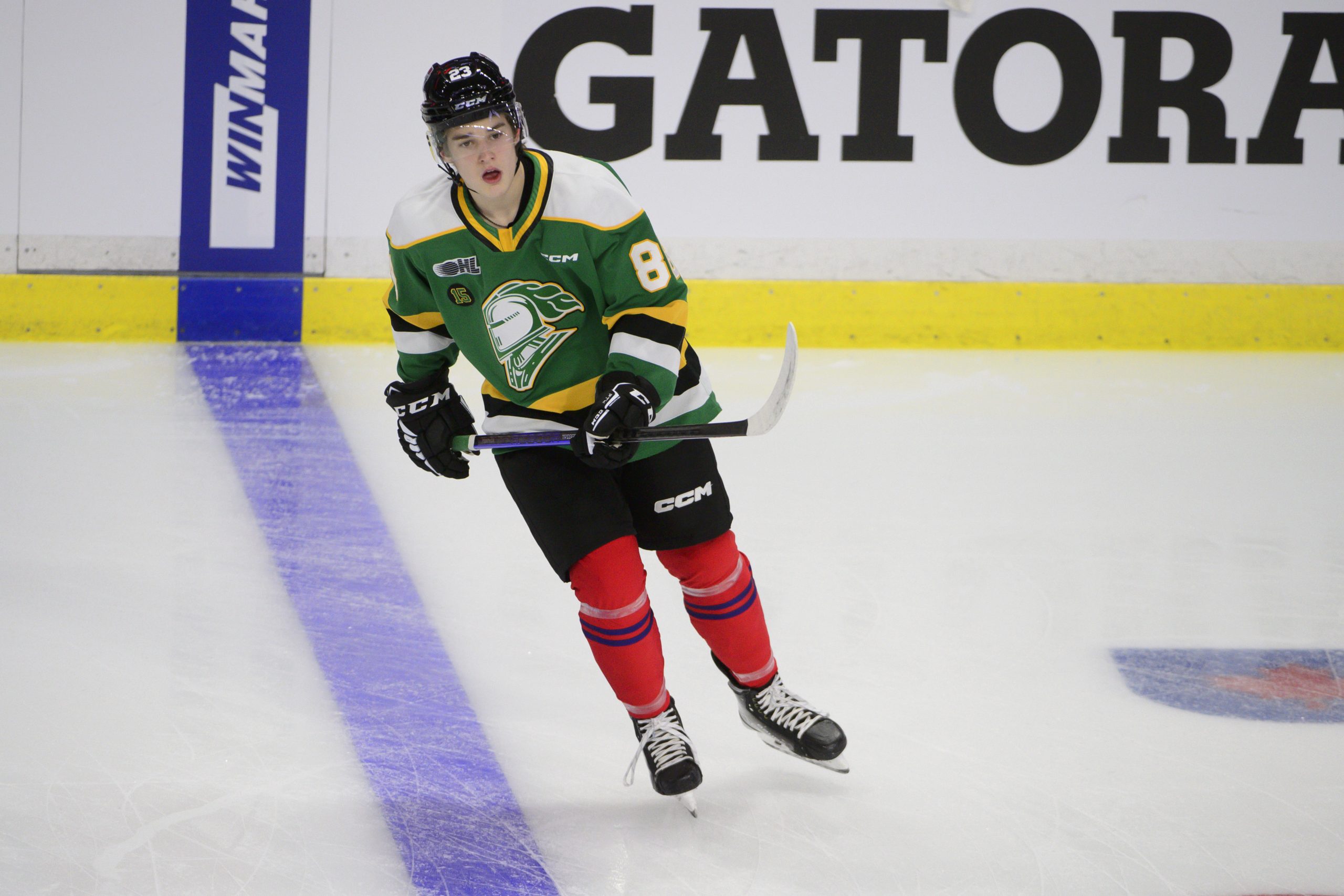Welcome back to Top Shelf Prospects, the column that brings you the next crop of professional hockey players. Each day our LWOS Prospects Writers will bring you a new player profile or topical article in the lead-up to the 2023 NHL Draft. Be sure to bookmark the site, follow Ben Kerr, Kyle Pereira and Frederik Frandson on Twitter, and spread the word for the site that will bring you analytical and critical profiles and scouting reports! Last Word On Hockey Prospects is your new headquarters for everything “NHL Draft”! Today we bring you our Denver Barkey Scouting Report.
Denver Barkey Scouting Report
Denver Barkey, born on April 27th, 2005, in Newmarket, Ontario, is a forward playing in the OHL. Playing for the London Knights, the young center stands at 5’9” and 154 pounds, making him one of the smallest players in the class. Despite the size limitations, Barkey still managed 22 goals and 37 assists for 59 points in 61 games. That came after an underwhelming rookie year, where he had just seven goals and 15 points in 53 games.
With a big step forward in production in his second season, he became a more well-known name in the class. He became a draft riser throughout the year, managing to be placed within the second and third rounds in the upcoming draft. Those rankings include being placed 38th by Smaht Scouting and Dobber Prospects, 52nd by Craig Button, 69th by Daily Faceoff, 74th by The Hockey News, 78th by Draft Prospects Hockey, 79th by Elite Prospects and Recruit Scouting, 80th by Bob McKenzie, McKeen’s Hockey, and FCHockey, and 81st by FloHockey.
Denver Barkey Deep Dive
Barkey, despite being small, was still placed early in the second by two notable sites in Dobber and Smaht. Both sites have historically been more lenient on smaller players if the skill is intriguing. Meanwhile, getting a ranking just outside the top-50 by Craig Button, which is influenced by scouts in the NHL, shows that some teams likely want him around that spot. So, what will a team get if they take a swing on him in the second round? Why might he fall into the third?
Denver Barkey’s Skating
Barkey is a decent skater. The best trait in his skating is his edge work. It is excellent. He’s able to change directions to stick with the play, as well as pull off tight turns without losing speed. As a smaller player, that’s largely unsurprising. On top of solid edge work, Barkey has really good acceleration. That is largely due to his crossovers, which are of course aided by his strong edges. Regardless, he generates quite a bit of speed off his first few steps out of a crossover.
However, once he hits his top speed and skates in a straight line, his speed is only above average. He’s not a burner, and he can’t beat defenders wide with his skating. That isn’t necessarily a bad thing, especially since his edges and acceleration are already good. Instead, it comes down to fixing stride mechanics, which an NHL skating a coach can do. He needs to get a lower centre of gravity in order to generate more power in his straight-line stride, as well as having longer strides. Once that is solved, which it likely will be, he can be a solid skater at the least.
Offensive Abilities
Barkey is an exceptionally smart player when it comes to the offensive zone. His primary weapon is his vision and play-reading ability. That is aided by his edges, in a sense that he can change his angle with his feet, allowing him to open passing or shooting lanes. When it comes to his vision, he does an exceptional job looking for opportunities to hit teammates in the slot. When he takes those chances, which are fairly frequent, he hits on them pretty consistently.
As for his shot, it’s not a strength. Barkey knows that too. He doesn’t shoot often, usually leaning more towards passing it off rather than taking it himself. Generally speaking, it’s the right play to make. But when he does shoot the puck, it’s not the most consistently accurate, nor does it have the power to beat goalies very often. He has to get closer to the net in order to be a threat, but his hands aren’t exactly great, and his smaller stature allows for defenders to keep him away from those areas. Barkey needs to bulk up, plain and simple, in order to find more success in the offensive zone.
Denver Barkey’s Transitional Abilities
Barkey’s transitional abilities are lackluster. To go off of what was said about his offensive game, his stickhandling and puck skills leave a lot to be desired. He doesn’t have the jaw dropping skill of Connor Bedard, the power of Adam Fantilli, or the creativity to pair with the smarts like Zach Benson. But perhaps the biggest issue with his transitional game is the lack of involvement.
Barkey is much more of a passenger or onlooker than he is a play driver or puck mover. He opts instead to let his teammates do the dirty work to get the puck up the ice and into the offensive zone. That’s not necessarily a negative, but it shows that he may not be able to lead his own line. When looking at stars around the league, like Connor McDavid, Nikita Kucherov, or Auston Matthews, they all do their work in the transitional game well and make their teammates better by doing that harder work. Barkey needs to become much more involved and lead his line at the junior level before he could be projected as a guy who could be handed the ropes to pull a line at the NHL level.
Barkey’s Defensive Zone Play
Barkey is an excellent defensive zone presence. That IQ that was mentioned for his offensive game is very noticeable in the defensive end. He reads the play incredibly well and always seems to be in the right spots to break up chances. Additionally, he has an excellent stick to take away passing or shooting lanes, or to discourage opponents to try for potential scoring chances.
Not only that, but he has an excellent motor. He forechecks very well, causing issues for his opponents to move up ice. If he fails to force issues, he back checks hard and effectively, though his speed and size can hinder him at times. Continuing to bulk up and working on his speed will make him all the more impressive in his own end or on the forecheck.
Denver Barkey’s Potential
Barkey is an interesting player to project. His skating needs work, as does his transitional abilities and shot. But, he has the IQ on both ends of the ice, he has the playmaking and overall offensive skill, and he has the motor that teams will covet. Bulking up and working on those aforementioned traits will allow him to develop a top-sx potential. However, that inability at this point to drive a line means if he were to play a top-six role, it would be largely as a complementary piece.
That being said, it’s more likely he rounds out as more of a third-line guy, used in tougher match-ups with some offensive upside. While the upside isn’t totally there, the floor appears high thanks to the rest of his game.
NHL Comparison
An NHL player who is comparable to Barkey, based only on style and not a projection of skills, is Yegor Sharangovich. Now, Sharangovich is a larger player than Barkey. By quite a bit at that. However, Sharangovich plays a very well-balanced game at both ends of the ice. He has a decent shot, but could be better, and has the ability to play with higher skilled players. His strength comes away from the puck, with a knack for getting into support spots to be an easy outlet to extend possession. Finally, Sharangovich is a solid defensive zone presence.
While Barkey is a smaller version of Sharangovich, in this case, he has higher offensive upside at this point. But if that part of his game does not round out, he can still play well away from the puck and play alongside high skill players within a top-six.
Raw stats via Elite Prospects
Main Photo: Anne-Marie Sorvin-USA TODAY Sports






